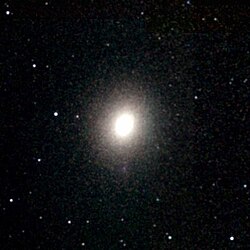Messier Index/M32
| Messier 32 | |
|---|---|
 Dwarf Elliptical Galaxy M32 | |
| Observation data (w:J2000 epoch) | |
| Constellation | Andromeda |
| Right ascension | 00h 42m 41.8s[1] |
| Declination | +40° 51′ 55″[1] |
| Redshift | -200 ± 6 km/s[1] |
| Distance | 2.49 ± 0.08 Mly (763 ± 24 kpc)[2][3][4]a |
| Type | cE2[1] |
| Apparent dimensions (V) | 8′.7 × 6′.5[1] |
| Apparent magnitude (V) | 9.0[1] |
| Notable features | w:satellite galaxy of the w:Andromeda Galaxy |
| Other designations | |
| M 32, NGC 221,[1] UGC 452,[1] PGC 2555,[1] Arp 168[1], LEDA 2555 | |

Messier 32 (also known as NGC 221 and w:Le Gentil) is a w:dwarf elliptical galaxy about 2.65 million w:light-years away in the w:constellation Andromeda. M32 is a w:satellite galaxy of the famous w:Andromeda Galaxy (M31) and was discovered by w:Le Gentil in w:1749. M32 measures only 6.5 ± 0.2 kly[5] in diameter at the widest point. Like most w:elliptical galaxies, M32 contains mostly older faint red and yellow stars with practically no dust or gas and consequently no current w:star formation.[6] It does, however, show hints of star formation in the relatively recent past.
The structure and stellar content of M32 is difficult to explain by traditional w:galaxy formation models. Recent simulations suggest a new scenario in which the strong tidal field of M31 can transform a w:spiral galaxy into a compact elliptical. As a small spiral galaxy falls into the central parts of M31, most of the outer layers of the smaller spiral are stripped away. The central bulge of the galaxy is much less affected and retains its morphology. Tidal effects trigger a massive star burst in the core, resulting in the high density of M32 we observe today.[7] There is also evidence that M32 has an outer disk.[8]
Distance measurements
At least two techniques have been used to measure distances to M32. The infrared w:surface brightness fluctuations distance measurement technique estimates distances to spiral galaxies based on the graininess of the appearance of their bulges. The distance measured to M32 using this technique is 2.46 ± 0.09 Mly (755 ± 28 kpc).[2] However, M32 is close enough that the w:tip of the red giant branch (TRGB) method may be used to estimate its distance. The estimated distance to M32 using this technique is 2.51 ± 0.13 Mly (770 ± 40 kpc).[3][4] Averaged together, these distance measurements give a distance estimate of 2.49 ± 0.08 Mly (763 ± 24 kpc).b
A recent paper argues that M32 may actually be a normal (non-dwarf) galaxy that is actually three times farther away, outside the w:Local Group.[9]
Notes
References
- ↑ a b c d e f g h i j "NASA/IPAC Extragalactic Database". Results for NGC 221. Retrieved 2006-11-29.
- ↑ a b Jensen, Joseph B.; Tonry, John L.; Barris, Brian J.; Thompson, Rodger I.; Liu, Michael C.; Rieke, Marcia J.; Ajhar, Edward A.; Blakeslee, John P. (2003). "Measuring Distances and Probing the Unresolved Stellar Populations of Galaxies Using Infrared Surface Brightness Fluctuations". Astrophysical Journal. 583 (2): 712–726. doi:10.1086/345430.
{{cite journal}}: Unknown parameter|month=ignored (help)CS1 maint: multiple names: authors list (link) - ↑ a b I. D. Karachentsev, V. E. Karachentseva, W. K. Hutchmeier, D. I. Makarov (2004). "A Catalog of Neighboring Galaxies". Astronomical Journal. 127: 2031–2068. doi:10.1086/382905.
{{cite journal}}: CS1 maint: multiple names: authors list (link) - ↑ a b Karachentsev, I. D.; Kashibadze, O. G. (2006). "Masses of the local group and of the M81 group estimated from distortions in the local velocity field". Astrophysics. 49 (1): 3–18. doi:10.1007/s10511-006-0002-6.
{{cite journal}}: CS1 maint: multiple names: authors list (link) - ↑ Diameter = distance × sin(diameter_angle) = 6.5 ± 0.2 kly. diameter
- ↑ Kepple, George Robert (1998). The Night Sky Observer's Guide, Volume 1. Willmann-Bell, Inc. p. 17. ISBN 0-943396-58-1.
{{cite book}}: Unknown parameter|coauthors=ignored (|author=suggested) (help) - ↑ Bekki, Kenji; Couch, Warrick J.; Drinkwater, Michael J.; Gregg, Michael D. (2001). "A New Formation Model for M32: A Threshed Early-Type Spiral Galaxy?". The Astrophysical Journal. 557: L39. doi:10.1086/323075.
{{cite journal}}: CS1 maint: multiple names: authors list (link) - ↑ Graham, A. W. (2002). "Evidence for an Outer Disk in the Prototype Compact Elliptical Galaxy M32". The Astrophysical Journal Letters. 568: L13. doi:10.1086/340274.
- ↑ Young, K. S. et al. (2008), A critical review of the evidence for M32 being a compact dwarf satellite of M31 rather than a more distant normal galaxy
